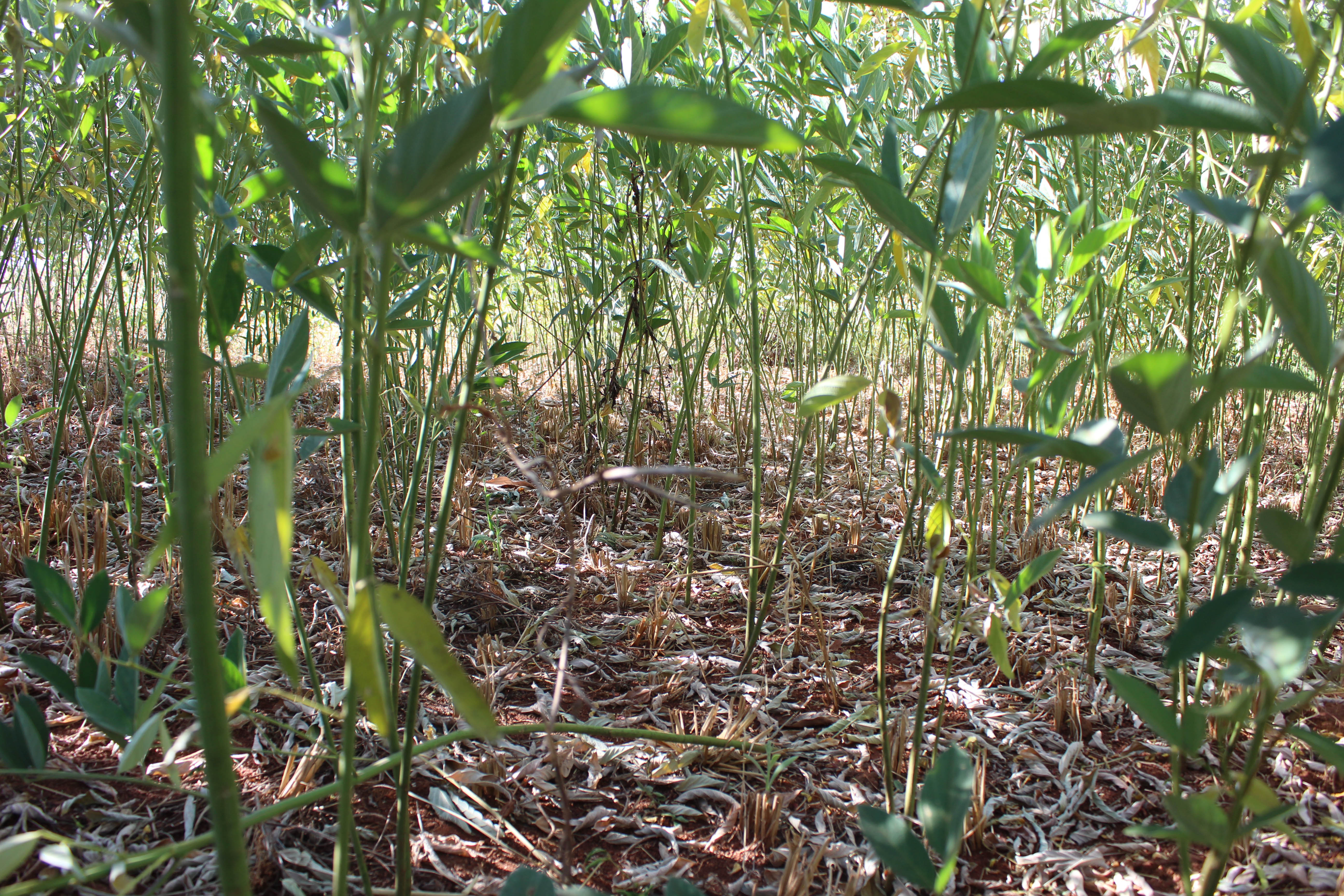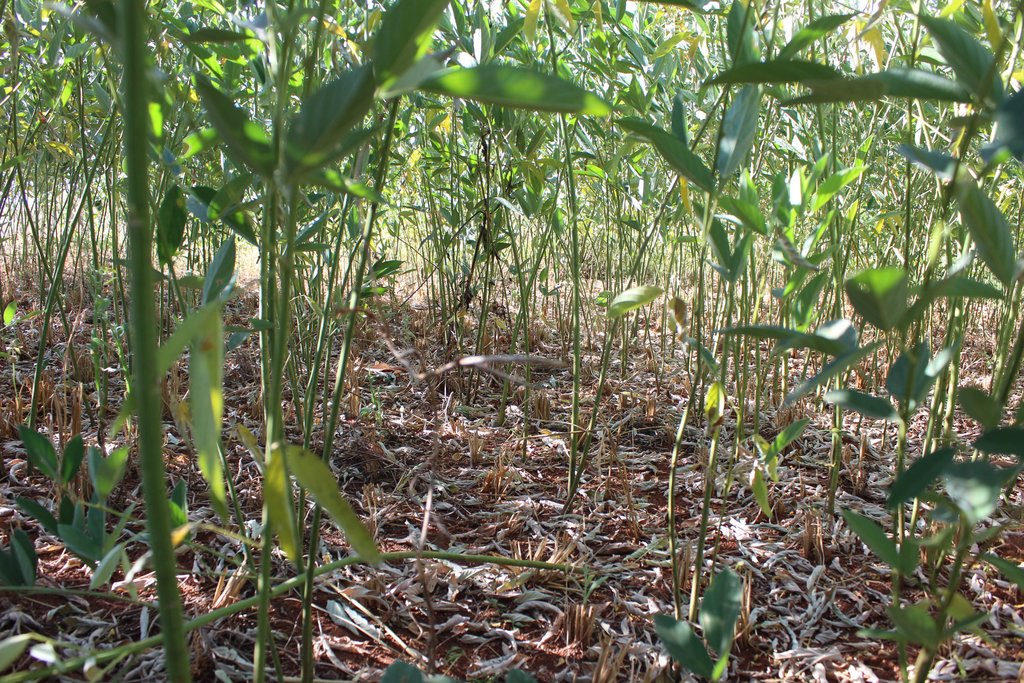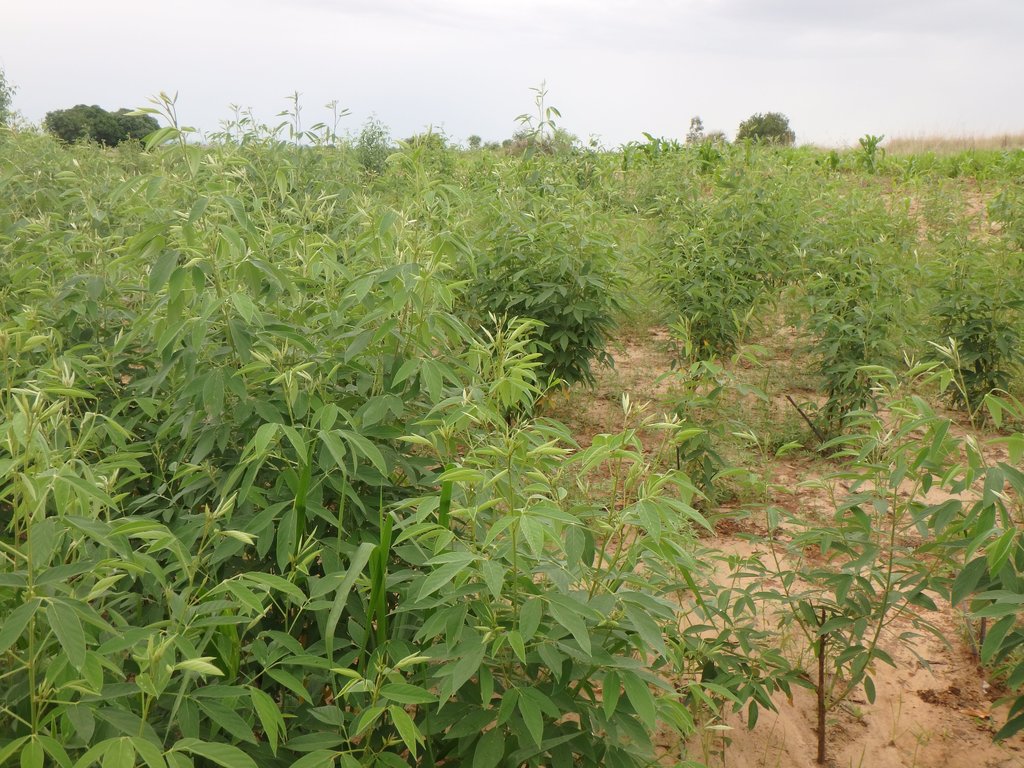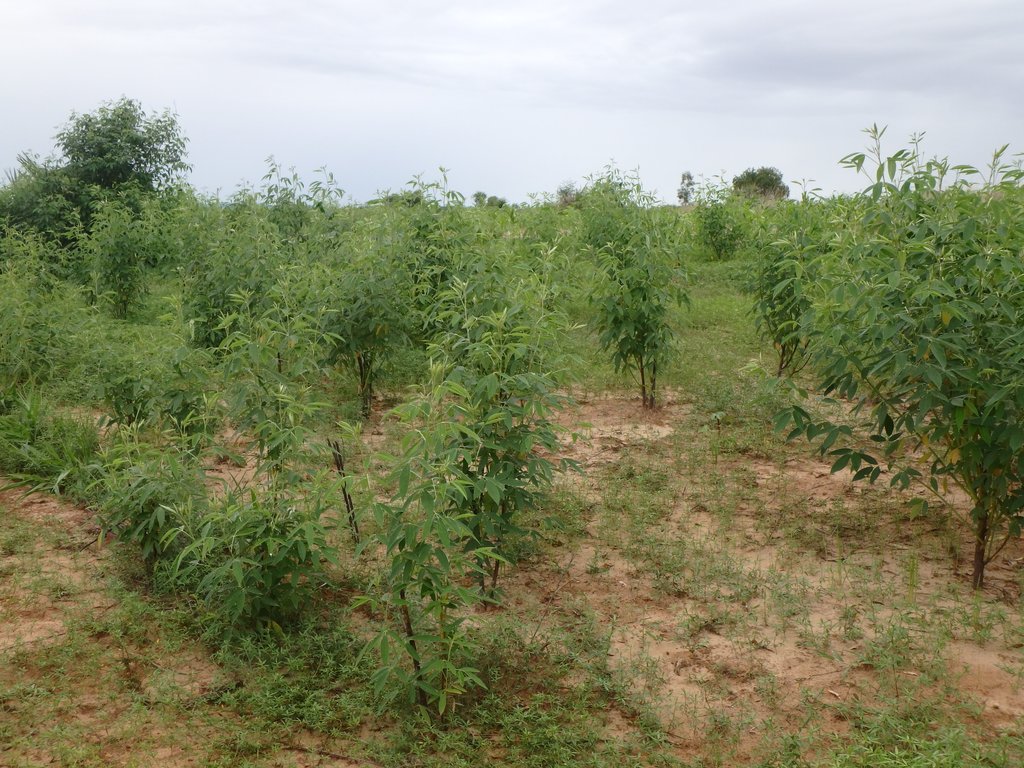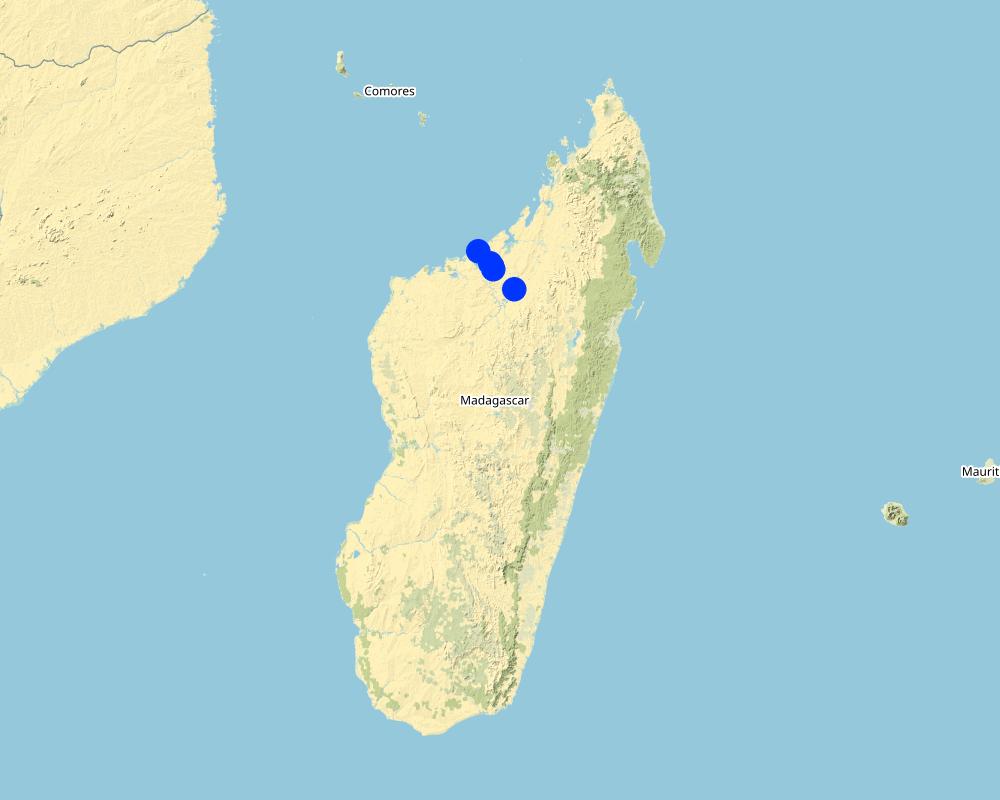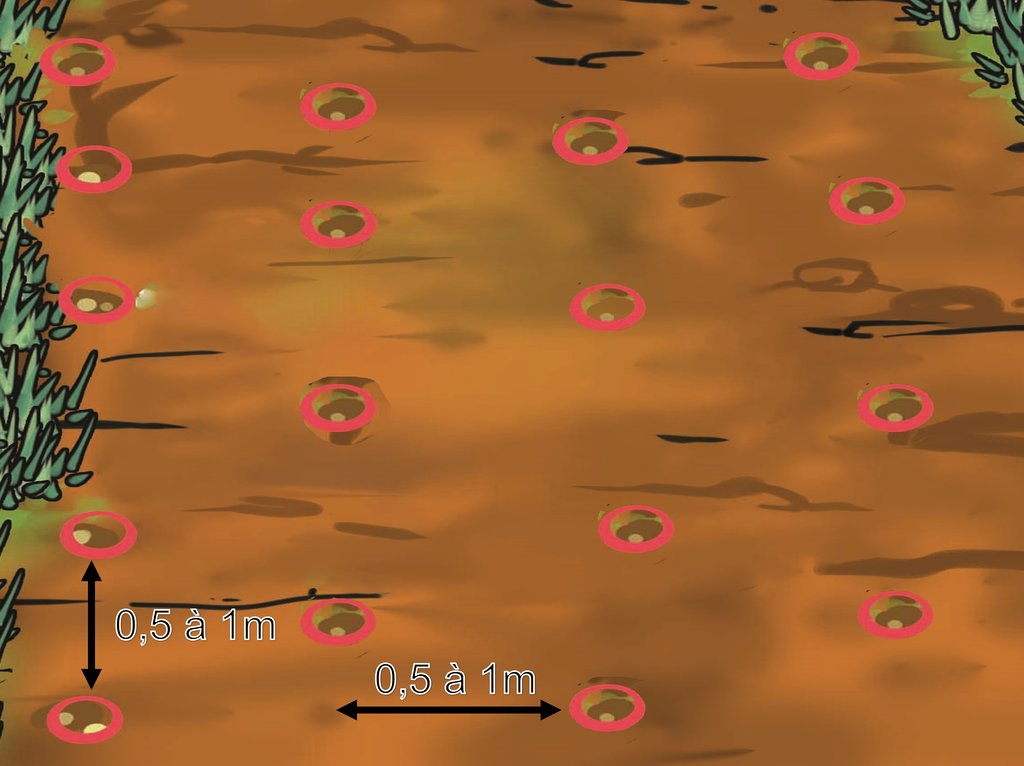Régénération du sol par les mini-forêts de Cajanus cajan [Madagascar]
- Creation:
- Update:
- Compiler: Harifidy RAKOTO RATSIMBA
- Editors: Felana Nantenaina RAMALASON, Dimby RAHERINJATOVOARISON, Siagbé Golli, Tahiry Ravivonandrasana, Natacha Rabeary
- Reviewers: William Critchley, Rima Mekdaschi Studer
Fanatsarana tany amin'ny fambolena alan'ambatry
technologies_6481 - Madagascar
View sections
Expand all Collapse all1. General information
1.2 Contact details of resource persons and institutions involved in the assessment and documentation of the Technology
Key resource person(s)
land user:
RAFARAMALALA Denise Germaine
Madagascar
land user:
FERDINAND
Madagascar
land user:
MAKA
Madagascar
land user:
RALAIMIDONA Jocelyn Jean Chrystophe
Madagascar
land user:
RANDRIANANDRASANA Tsimihery Jean
Madagascar
Name of project which facilitated the documentation/ evaluation of the Technology (if relevant)
Soil protection and rehabilitation for food security (ProSo(i)l)Name of the institution(s) which facilitated the documentation/ evaluation of the Technology (if relevant)
Deutsche Gesellschaft für Internationale Zusammenarbeit (GIZ)1.3 Conditions regarding the use of data documented through WOCAT
The compiler and key resource person(s) accept the conditions regarding the use of data documented through WOCAT:
Ja
1.4 Declaration on sustainability of the described Technology
Is the Technology described here problematic with regard to land degradation, so that it cannot be declared a sustainable land management technology?
Nee
2. Description of the SLM Technology
2.1 Short description of the Technology
Definition of the Technology:
Le pois d’Angole (Cajanus cajan var indica) est une légumineuse arbustive pluriannuelle, qui se développe bien sur les sols pauvres et résiste bien au manque d’eau. La culture de pois d’Angole permet de restaurer les sols pauvres tout en produisant des ressources alimentaires, fourragères et du bois de chauffe.
2.2 Detailed description of the Technology
Description:
La culture de pois d'Angole peut se pratiquer sur les sols épuisés ou peu fertiles, aussi bien sur les parcelles en pente douce que sur les bas-fonds non inondés.
Le semis se fait au début de la saison des pluies. Si l’exploitant a pour priorité la restauration de la fertilité des sols, l’écartement recommandé entre les plants est de 50 cm. Le semis se fait avec 2 grains par poquet, ce qui correspond à 20 kg de semences par ha.
Si l’adoptant souhaite récolter le maximum de graines (pour la consommation), il est recommandé de porter l’écartement entre les lignes à 1 m. La quantité de semences sera alors de 10 kg/ha.
Dans les deux cas, il est recommandé de semer les plants en quinconce d’une ligne à l’autre. Un sarclage autour des jeunes plants est souhaitable en début de culture.
Au début de la deuxième saison des pluies, les plants sont taillés à une hauteur de 40 cm et les produits de la taille sont répandus sur le sol ou en partie exportés pour alimenter les animaux. Le bois collecté peut aussi être utilisé comme bois de chauffe. La coupe d’un rang sur deux peut être effectuée si la biomasse est bien développée, afin d’augmenter la production de graine. A partir de la troisième année, il est généralement possible d’éclaircir encore davantage la mini-forêt et de réintroduire des cultures peu exigeantes comme celles du manioc.
L'un des avantages de cette technologie est la restauration de la fertilité des sols. L’enracinement profond des racines pivotantes permet de récupérer des éléments minéraux en profondeur et de les restituer en surface sous forme d’une litière abondante. Il favorise ainsi la reprise de l’activité biologique des sols et aussi la fixation de l'azote atmosphérique. La couverture de pois d’Angole limite également l’érosion superficielle.
Avec cette technologie, il est possible de produire à la fois des graines comestibles, du fourrage pour les animaux et du bois de chauffe. Les exploitants des terres utilisent cette technique sur une superficie moyenne de 0,5 à 1 ha dans la Région.
2.3 Photos of the Technology
2.5 Country/ region/ locations where the Technology has been applied and which are covered by this assessment
Country:
Madagascar
Region/ State/ Province:
Boeny
Further specification of location:
Ambalakida, Belobaka, Ambondromamy, Marovoay Banlieue, Antanambao Andranolava
Specify the spread of the Technology:
- evenly spread over an area
If precise area is not known, indicate approximate area covered:
- < 0.1 km2 (10 ha)
Is/are the technology site(s) located in a permanently protected area?
Nee
Map
×2.6 Date of implementation
Indicate year of implementation:
2020
If precise year is not known, indicate approximate date:
- less than 10 years ago (recently)
2.7 Introduction of the Technology
Specify how the Technology was introduced:
- through projects/ external interventions
Comments (type of project, etc.):
GIZ ProSol Madagascar
3. Classification of the SLM Technology
3.1 Main purpose(s) of the Technology
- improve production
- reduce, prevent, restore land degradation
- protect a watershed/ downstream areas – in combination with other Technologies
- create beneficial economic impact
3.2 Current land use type(s) where the Technology is applied
Land use mixed within the same land unit:
Nee

Cropland
- Perennial (non-woody) cropping
- Pois d'Angole (Cajanus)
Number of growing seasons per year:
- 1
Is intercropping practiced?
Nee
Is crop rotation practiced?
Ja
If yes, specify:
Après 3 ans de culture de pois d'angole, l'association de céréales (riz, sorgho, maïs, etc.) avec des légumineuses peut se faire selon suivie de la culture de manioc, et enfin, une replantation de pois d'angole sur trois ans et le cycle continue.
3.3 Has land use changed due to the implementation of the Technology?
Has land use changed due to the implementation of the Technology?
- Yes (Please fill out the questions below with regard to the land use before implementation of the Technology)
Land use mixed within the same land unit:
Nee

Cropland
- Annual cropping
Annual cropping - Specify crops:
- cereals - maize
- oilseed crops - groundnuts
Is intercropping practiced?
Nee
Is crop rotation practiced?
Nee

Unproductive land
Specify:
Savane
Remarks:
Il s'agit des savanes herbeuses que les exploitants veulent cultiver après 3 ans de culture de pois d'Angole car ce dernier restaure la fertilité du sol. Il en est de même pour les zones de monoculture, qui sont souvent épuisées. D'où le changement d'utilisation des terres.
3.4 Water supply
Water supply for the land on which the Technology is applied:
- rainfed
3.5 SLM group to which the Technology belongs
- rotational systems (crop rotation, fallows, shifting cultivation)
- improved ground/ vegetation cover
- integrated soil fertility management
3.6 SLM measures comprising the Technology

agronomic measures
- A1: Vegetation/ soil cover
- A2: Organic matter/ soil fertility

vegetative measures
- V1: Tree and shrub cover
- V2: Grasses and perennial herbaceous plants
3.7 Main types of land degradation addressed by the Technology

soil erosion by water
- Wt: loss of topsoil/ surface erosion

soil erosion by wind
- Et: loss of topsoil

chemical soil deterioration
- Cn: fertility decline and reduced organic matter content (not caused by erosion)

biological degradation
- Bc: reduction of vegetation cover
3.8 Prevention, reduction, or restoration of land degradation
Specify the goal of the Technology with regard to land degradation:
- reduce land degradation
- restore/ rehabilitate severely degraded land
4. Technical specifications, implementation activities, inputs, and costs
4.1 Technical drawing of the Technology
Technical specifications (related to technical drawing):
La densité recommandée pour la restauration des sols correspond à un écartement variant de 50 cm à 1 m en fonction de la pauvreté du sol. La configuration des poquets est en quinconce, et chaque poquet reçoit 2 grains lors du semis.
Au fil des années, il est possible de réduire la densité en supprimant un rang sur deux. A partir de la troisième année, si le sol montre des signes suffisants d'amélioration, il est possible de procéder à des cultures en couloir avec des espèces alimentaires.
Author:
GIZ ProSol Madagascar
Date:
01/02/2023
4.2 General information regarding the calculation of inputs and costs
Specify how costs and inputs were calculated:
- per Technology area
Indicate size and area unit:
1 hectare
other/ national currency (specify):
ariary
If relevant, indicate exchange rate from USD to local currency (e.g. 1 USD = 79.9 Brazilian Real): 1 USD =:
4300.0
Indicate average wage cost of hired labour per day:
7500
4.3 Establishment activities
| Activity | Timing (season) | |
|---|---|---|
| 1. | Desherbage du terrain | Septembre - Octobre |
| 2. | Travail du sol (charrue + herse) | Novembre - Décembre |
| 3. | Semis | Décembre - Janvier |
4.4 Costs and inputs needed for establishment
| Specify input | Unit | Quantity | Costs per Unit | Total costs per input | % of costs borne by land users | |
|---|---|---|---|---|---|---|
| Labour | Desherbage du terrain | jours-personne | 10.0 | 7500.0 | 75000.0 | 100.0 |
| Labour | Semis | jours-personne | 20.0 | 7500.0 | 150000.0 | 100.0 |
| Equipment | Travail du sol (charrue + herse) | traction animale | 6.0 | 25000.0 | 150000.0 | 100.0 |
| Equipment | Machette | Nombre | 4.0 | 15000.0 | 60000.0 | 100.0 |
| Plant material | Semence pois d'angole | kg | 20.0 | 4000.0 | 80000.0 | |
| Total costs for establishment of the Technology | 515000.0 | |||||
| Total costs for establishment of the Technology in USD | 119.77 | |||||
If land user bore less than 100% of costs, indicate who covered the remaining costs:
Les semences ont été données par le projet ProSol GIZ Madagascar.
4.5 Maintenance/ recurrent activities
| Activity | Timing/ frequency | |
|---|---|---|
| 1. | Taille/coupe | 1 fois par an en Décembre ou Janvier |
Comments:
Le sarclage est optionnel lorsque la culture de pois d'Angole est faite pour la restauration des sols.
4.6 Costs and inputs needed for maintenance/ recurrent activities (per year)
| Specify input | Unit | Quantity | Costs per Unit | Total costs per input | % of costs borne by land users | |
|---|---|---|---|---|---|---|
| Labour | Taille/coupe | jours-personne | 4.0 | 7500.0 | 30000.0 | 100.0 |
| Total costs for maintenance of the Technology | 30000.0 | |||||
| Total costs for maintenance of the Technology in USD | 6.98 | |||||
4.7 Most important factors affecting the costs
Describe the most determinate factors affecting the costs:
Mains d'œuvre pour la mise en place
5. Natural and human environment
5.1 Climate
Annual rainfall
- < 250 mm
- 251-500 mm
- 501-750 mm
- 751-1,000 mm
- 1,001-1,500 mm
- 1,501-2,000 mm
- 2,001-3,000 mm
- 3,001-4,000 mm
- > 4,000 mm
Specify average annual rainfall (if known), in mm:
1400.00
Agro-climatic zone
- sub-humid
5.2 Topography
Slopes on average:
- flat (0-2%)
- gentle (3-5%)
- moderate (6-10%)
- rolling (11-15%)
- hilly (16-30%)
- steep (31-60%)
- very steep (>60%)
Landforms:
- plateau/plains
- ridges
- mountain slopes
- hill slopes
- footslopes
- valley floors
Altitudinal zone:
- 0-100 m a.s.l.
- 101-500 m a.s.l.
- 501-1,000 m a.s.l.
- 1,001-1,500 m a.s.l.
- 1,501-2,000 m a.s.l.
- 2,001-2,500 m a.s.l.
- 2,501-3,000 m a.s.l.
- 3,001-4,000 m a.s.l.
- > 4,000 m a.s.l.
Indicate if the Technology is specifically applied in:
- not relevant
5.3 Soils
Soil depth on average:
- very shallow (0-20 cm)
- shallow (21-50 cm)
- moderately deep (51-80 cm)
- deep (81-120 cm)
- very deep (> 120 cm)
Soil texture (topsoil):
- coarse/ light (sandy)
- medium (loamy, silty)
Soil texture (> 20 cm below surface):
- medium (loamy, silty)
Topsoil organic matter:
- medium (1-3%)
- low (<1%)
5.4 Water availability and quality
Ground water table:
5-50 m
Availability of surface water:
medium
Water quality (untreated):
poor drinking water (treatment required)
Water quality refers to:
ground water
Is water salinity a problem?
Nee
Is flooding of the area occurring?
Nee
5.5 Biodiversity
Species diversity:
- medium
Habitat diversity:
- low
Comments and further specifications on biodiversity:
Plusieurs espèces faunistiques et floristiques sont présentes dans cette Région, certaines sont même endémiques. Néanmoins, cette quantité reste moyenne par rapport à d'autres Régions de l'île. Concernant les habitats, environ 20% de la zone peut constituer un habitat pour cette biodiversité (forêts, plan d'eau, mangrove, etc.), ce qui reste assez faible.
5.6 Characteristics of land users applying the Technology
Sedentary or nomadic:
- Sedentary
Market orientation of production system:
- mixed (subsistence/ commercial)
Off-farm income:
- 10-50% of all income
Relative level of wealth:
- average
Individuals or groups:
- individual/ household
- groups/ community
Level of mechanization:
- manual work
Gender:
- women
- men
Age of land users:
- youth
- middle-aged
5.7 Average area of land used by land users applying the Technology
- < 0.5 ha
- 0.5-1 ha
- 1-2 ha
- 2-5 ha
- 5-15 ha
- 15-50 ha
- 50-100 ha
- 100-500 ha
- 500-1,000 ha
- 1,000-10,000 ha
- > 10,000 ha
Is this considered small-, medium- or large-scale (referring to local context)?
- medium-scale
5.8 Land ownership, land use rights, and water use rights
Land ownership:
- individual, not titled
- individual, titled
Land use rights:
- individual
Water use rights:
- open access (unorganized)
Are land use rights based on a traditional legal system?
Ja
Specify:
Celui qui s'occupe de terres en est le propriétaire.
5.9 Access to services and infrastructure
health:
- poor
- moderate
- good
education:
- poor
- moderate
- good
technical assistance:
- poor
- moderate
- good
employment (e.g. off-farm):
- poor
- moderate
- good
markets:
- poor
- moderate
- good
energy:
- poor
- moderate
- good
roads and transport:
- poor
- moderate
- good
drinking water and sanitation:
- poor
- moderate
- good
financial services:
- poor
- moderate
- good
6. Impacts and concluding statements
6.1 On-site impacts the Technology has shown
Socio-economic impacts
Production
crop production
crop quality
Income and costs
expenses on agricultural inputs
farm income
workload
Socio-cultural impacts
food security/ self-sufficiency
Ecological impacts
Water cycle/ runoff
surface runoff
Soil
soil moisture
Biodiversity: vegetation, animals
Vegetation cover
biomass/ above ground C
Specify assessment of on-site impacts (measurements):
Il s'agit des estimations des exploitants enquêtés.
6.2 Off-site impacts the Technology has shown
downstream siltation
Comments/ specify:
L'envasement des rizières en aval est réduit donc cette situation est bénéfique.
damage on neighbours' fields
Specify assessment of off-site impacts (measurements):
Il s'agit des estimations des exploitants enquêtés.
6.3 Exposure and sensitivity of the Technology to gradual climate change and climate-related extremes/ disasters (as perceived by land users)
Gradual climate change
Gradual climate change
| Season | increase or decrease | How does the Technology cope with it? | |
|---|---|---|---|
| annual temperature | increase | not well | |
| annual rainfall | decrease | moderately |
Climate-related extremes (disasters)
Meteorological disasters
| How does the Technology cope with it? | |
|---|---|
| tropical storm | moderately |
Biological disasters
| How does the Technology cope with it? | |
|---|---|
| insect/ worm infestation | not well |
6.4 Cost-benefit analysis
How do the benefits compare with the establishment costs (from land users’ perspective)?
Short-term returns:
slightly negative
Long-term returns:
positive
How do the benefits compare with the maintenance/ recurrent costs (from land users' perspective)?
Short-term returns:
slightly negative
Long-term returns:
positive
6.5 Adoption of the Technology
- single cases/ experimental
6.6 Adaptation
Has the Technology been modified recently to adapt to changing conditions?
Nee
6.7 Strengths/ advantages/ opportunities of the Technology
| Strengths/ advantages/ opportunities in the land user’s view |
|---|
| Sol regénéré et partiellement protégé contre l'érosion hydrique et éolienne de surface. Augmentation de la production agricole après l'enlèvement de la culture de pois d'angole sur la parcelle. |
| Source de revenu supplémentaire par la vente des graines. Une partie de la production sert également de nourriture et de bois de chauffe pour les exploitants. |
| Strengths/ advantages/ opportunities in the compiler’s or other key resource person’s view |
|---|
| Pour la restauration des sols, aucun traitement nécessaire et la quantité de travail est très faible. |
| Une fois la mise en place effectuée , il n'y a plus besoin de travailler sur la parcelle pendant 2 à 3 ans : seulement pour les récoltes des pois et de bois. |
6.8 Weaknesses/ disadvantages/ risks of the Technology and ways of overcoming them
| Weaknesses/ disadvantages/ risks in the land user’s view | How can they be overcome? |
|---|---|
| Certaines personnes ne sont pas encore convaincues des avantages de la technologie et sont découragées. | Plus de pratique et de sensibilisation. |
| Weaknesses/ disadvantages/ risks in the compiler’s or other key resource person’s view | How can they be overcome? |
|---|---|
|
La culture du pois d’Angole est assez vulnérable aux insectes qui engendrent des dégâts sur les gousses. |
Soit appliquer des traitements efficaces (ce qui prend du temps, un coût assez conséquent et affecte l’environnement s’il s'agit de pesticides). Soit bien veiller à espacer fortement les zones de culture de pois d’Angole et éviter notamment les zones de culture pures de légumineuses. |
| Il n’existe pas encore de débouchés commerciaux importants pour cette culture. Les récoltes sont donc essentiellement destinées à l’autoconsommation, ce qui limite l’ambition des paysans à cultiver le pois d’Angole en grande quantité. | Travailler sur la commercialisation de cette espèce afin qu’elle puisse être une source de revenus supplémentaires. |
7. References and links
7.1 Methods/ sources of information
- field visits, field surveys
5 terrains visités
- interviews with land users
5 exploitants interrogés
- compilation from reports and other existing documentation
Fiche technique GIZ ProSol Madagascar
When were the data compiled (in the field)?
31/01/2023
7.2 References to available publications
Title, author, year, ISBN:
Région Boeny, 2016, "Schéma Régional d’Aménagement du Territoire de la Région Boeny"
Available from where? Costs?
Hotel de la Région Boeny
Title, author, year, ISBN:
GIZ ProSol Madagascar, 2020, Poster "Pois d’Angole"
Available from where? Costs?
GIZ ProSol Madagascar
Title, author, year, ISBN:
GIZ ProSol Benin, 2018, "Manuel de l’agriculteur"
Available from where? Costs?
GIZ ProSol Benin
Title, author, year, ISBN:
GRET, 2015, "Pratiques agroécologiques et agroforestières en zone tropicale humide", Fiche N°7 Jachère améliorée
Available from where? Costs?
https://gret.org/publication/pratiques-agroecologiques-et-agroforestieres-en-zone-tropicale-humide/
Links and modules
Expand all Collapse allLinks
No links
Modules
No modules


